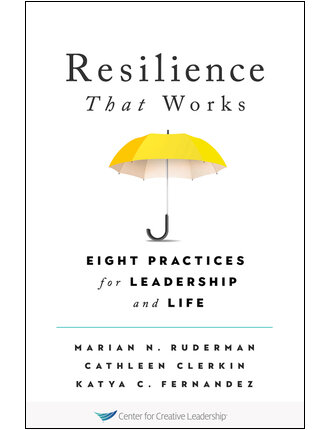Resilience That Works: Eight Practices for Leadership and Life
Stop me if you’ve heard this before: A longtime nonprofit manager who’s spent her entire career steeped in the inner workings of the sector becomes the head of an organization. She works tirelessly, rarely takes a vacation, successfully steers it through a difficult financial period, seemingly by force of will, and no one ever doubts that she has the organization’s best interests in mind. But within five years, she steps down and never leads another organization.
Was she not the right fit for that particular organization? Was it burnout?
I suspect that if she’d had a chance to read Resilience That Works: Eight Practices for Leadership and Life, by Marian N. Ruderman, Cathleen Clerkin, and Katya C. Fernandez, such a leader might have had a better experience and a more enduring tenure.
Written as the coronavirus began to spread around the world and published by the Center for Creative Leadership (CCL), where the authors were working at the time (Clerkin is now senior director of insights at Candid, and Fernandez is at Stanford University), the book aims to help nonprofit leaders examine their work and their approaches to work and guide them to be better able to sustain their energies.
Resilience That Works is highly accessible and offers real-world examples. And while it sometimes approaches “touchy-feely” advice, it remains professional and appropriate. Every leader, they write, faces a challenge at some point for which they feel unprepared. Most of them bear down and work harder and longer, they take on greater responsibilities, and they push aside other aspects of their lives. But they also learn that such an approach can only succeed for so long: “If the [vicious spiral] isn’t interrupted, leaders often end up burned out, seriously damaging their own health and well-being, and negatively impacting the people around them.”
According to the authors, resilience is more than simply “bouncing back” from a challenge. Instead, they liken it to the Japanese art of kintsugi, in which broken pottery is repaired by filling the broken seams with gold and other precious metals. The resulting beauty could not have occurred without the breakage and reconstruction.
Resilient leaders, CCL studies have shown, are viewed by colleagues as more effective. “What we find particularly fascinating,” they write, “is that [the studies] suggest that resilience is visible. In other words, being resilient doesn’t just make you feel better on the inside, it also affects how others see your performance.”
Resilience That Works helps nonprofit leaders assess their own resilience and develop a “resilience portfolio,” comparing it to a retirement plan. And just as such plans should diversify their investment portfolios, leaders should learn to diversify their resilience portfolios by including elements of physical, mental, emotional, and social practices.
After breaking down what resilience means and providing an overview of the way biology shapes one’s response to stress (e.g., we could all use more sleep), the book outlines eight research-based approaches to cultivating resilience: consistent exercise, sleep, mindfulness, cognitive reappraisal, savoring, gratitude, social connection, and touch.
[T]he book outlines eight research-based approaches to cultivating resilience: consistent exercise, sleep, mindfulness, cognitive reappraisal, savoring, gratitude, social connection, and touch.
For example, no matter how busy your schedule is, build time—even if it’s just 15 minutes—into each day to incorporate physical activity, which can help maintain your mental acuity as well as your physical well-being. To address sleep deprivation, which the authors argue can jeopardize cognitive processes, keep sleep and waking times consistent.
The authors distinguish “mindfulness” from “meditation,” by explaining that the former is less specific, referring to a general state of awareness. Cognitive reappraisal might be summed up by saying “don’t jump to conclusions,” especially when it comes to the actions of co-workers. Savoring aims to prolong the positive, which the authors write “can help you feel like you have more personal resources to draw from during times of challenge and change.” The importance of being thankful and expressing gratitude benefits both the giver and receiver.
Investing in relationships is a vital part of social connections, the authors argue, “as leadership is a social process,” and when leaders are not communicating, it’s harder to address complex situations.
The approach that surprised me most was touch, and it reminded me of a very personal moment in my own career that still surprises me: My mother died on a Thursday in 2017, but I decided to return to the office the following day since Fridays were the busiest day of the week for our department. In retrospect, I probably should have stayed home that day; I had a lot on my mind. During lunch, I sat in our communal cafeteria and a colleague approached me. She had heard about my loss and asked if it was all right if she gave me a hug. I assured her it was fine to do so. For years, that hug has been one of the most enduring memories of the time surrounding my mother’s death: her asking permission, the simple human embrace, and the gratitude I felt.
To be clear, Ruderman, Clerkin, and Fernandez distinguish between appropriate and inappropriate workplace contact; they clearly define what they mean. They mean “socio-physical contact,” or touch support, such as holding hands, hugging, patting someone on the back, high-fiving, or even cuddling a pet. After these last two years, the value of touch and of social connection have never seemed so clear and their necessity so obvious. It’s an area rarely discussed in books about nonprofit leadership, but the loss of connectivity to co-workers may pose the biggest challenge of the COVID era.
In the final section, the authors guide readers in creating plans for themselves to cultivate resilience and make it a regular part of their lives. The approaches will be familiar to anyone who has tried to break a bad habit, such as repetition, progressing through a series of small steps, and keeping track of your progress. And the examples and exercises are practical and accessible.
Indeed, I would argue that “practical and accessible” sums up the book overall. Nonprofit leaders and staff who aspire to take on greater responsibility at their job would find it useful, and it even offers useful approaches for developing resilience in one’s life in general.
Matt Sinclair is editor of Philanthropy News Digest.








